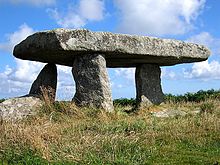Lanyon Quoit
The Lanyon Quoit , also known as The Giant's Quoit and The Giant's Table , is an approximately 5500 year old dolmen from the Neolithic Age and the most famous quoit in Cornwall .
location
Lanyon Quoit is northwest of Penzance between Madron and Morvah . It is located 3 km after Madron in a northerly direction 50 m to the right of the road. There are more megalithic sites within a few kilometers :
- Boskednan stone circle
- Boscawen-ûn
- Chûn Quoit
- Mên-an-Tol
- Merry Maidens
- Mulfra Quoit
- Tregeseal stone circle
- Tregiffian
- Zennor Quoit
construction
The Lanyon Quoit consists of three approximately 2.0 m high pillars on which an oval, approximately 13-tonne cover plate rests. The lengths of the axes of the approximately symmetrical cover plate are 2.75 m and 5.25 m. One pillar supports the plate almost centrally, the other two support the edge of the plate. The position and orientation of the edge pillars are not symmetrical to the axis of the oval cover plate. This impression is only created with a suitable choice of location, as the pictures show. Around the re-erected stone monument there are menhirs , the original arrangement and function of which are unclear, and at the southern end of the area remains of stone boxes , so that a more extensive cult complex can be assumed.
history
In 1769, William Borlase described the megalithic complex for the first time in a publication and produced the etchings on the right for illustration, in which the Lanyon Quoit has a significantly different appearance than today in terms of structure and floor plan. Scott's depiction from 1813 also shows a different arrangement of the megaliths from the current one and corresponds to that of Borlase. William Cotton reported in his work how the monument was redesigned in the 19th century. In 1815 the Lanyon Quoit collapsed in a storm and was rebuilt in 1824 with financial support from local residents and under the guidance of Captain Giddy of the Royal Navy. However, the reconstruction did not quite match the original appearance of the facility, as a pillar and part of the cover plate had broken off when it collapsed. Therefore, Captain Giddy had the remaining three support stones moved a little and the cover plate rotated by 90 ° so that it now only rested on three pillars. As Borlase's drawing shows, the pillars, including a much wider stone that no longer exists in this form, had previously stood parallel to each other. In addition, the facility must once have been higher, as Borlase had reported that a man could ride upright under it. An etching by R. T. Pentreath from 1857 shows the megaliths already in the order we know today. In 1864, John Thomas Blight made an etching in his work A Week at the Land's End , which also shows the redesigned Lanyon Quoits. In 1872, William Copeland Borlase , a great-grandson of the elder Borlase, carried out further studies and archaeological digs. He reproduced etchings by his ancestor and found them to be far more valuable than any other contemporary sketch, as the monument has undergone significant changes since then. In 1952, the then owner Edward Bolitho from Trengwainton handed over the property with the monument to the National Trust .
More recently, specific ideas about the appearance and purpose of the complex have been developed: Today archaeologists suspect that the stone formation, like the other nearby quoits, was once the burial chamber of a portal grave or was a cenotaph , a memorial for deceased, highly respected priest-shamans . It is disputed whether the chamber was completely covered with earth or whether the entrance area was exposed together with the cover plate. Before, inside or on the rock formation could then rites have been performed. It is also unclear how the 13-ton capstone could be moved to a height of two meters by human hands. Transport via a very long, artificially raised ramp is conceivable. A successive lifting of the stone by means of a wooden construction also appears possible, a method that can also be used for the cap stones from Stonehenge .
literature
- John Barnatt: Prehistoric Cornwall: The ceremonial monuments . Turnstone Press, 1982, ISBN 0855001291 .
- Ian McNeil Cooke: Standing Stones of the Land's End . Men-an-Tol Studio, Cornwall, 1998, ISBN 0951237195 .
- Homer Sykes: Mysterious Britain - Fact and Folklore . Weidenfeld and Nicholson 1993, ISBN 0297831968 , p. 22.
Web links
Individual evidence
- ^ William Borlase: Antiquities Historical and Monumental of the County of Cornwall , Bowyer and Nichols, London 1769
- ^ Wilks: The Gallery of Nature and Art , London 1813
- ^ William Cotton: Stone Circles, Cromlehs and other remains of the aboriginal Britons in the West of Cornwall , 1827
- ^ Richard Edmonds: The Land's End District and its Antiquities, Natural History, Natural Phenomena and Scenery , Smith 1862
- ^ John Thomas Blight: A Week at the Land's End , Longman 1861
- ^ William Copeland Borlase: Naenia Cornubiae , Longmans 1872
- ^ John Barnatt: Prehistoric Cornwall: The ceremonial monuments , Turnstone Press 1982
Coordinates: 50 ° 8 ′ 50.5 " N , 5 ° 35 ′ 56.5" W.





